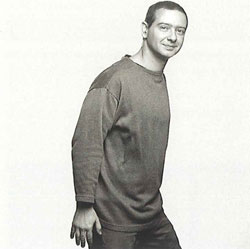Pedro Proença
Pedro ProençaAngola ¶ 1962
 |
|
| Créditos fotográficos / Photographic credits: Abílio Leitão |
Due to his very peculiar style of drawing and his extraordinary verve, he became an artist with a strongly rooted presence in Portugal, one of the most active of his generation. In 1982, when he co-founded the Homeostético movement, he was still studying at the Fine Arts School of Lisbon. Proença was the writer of most of the movement's manifestos. His own burgeoning individual career would, however, begin in 1984. ¶ In Proença's oeuvre, drawing is primary, underlined by both a meticulous graphic technique and an unrestricted imagination. Proença's figurativism is metamorphic, expansive, and ornamental. Firstly, it is metamorphic for, by using human, animal and plant forms, he constructs via rhythms, perversions and deformations that transform the ones into the others. His drawings seem to be deprived of both a beginning and an end, scattering in all possible directions like climbing plants, to the point where they can take up the whole exhibition space. In this sense they are very similar to site-specific installations. The very fact that space can be gobbled up entirely allows us to refer to its ornamental facet or vocation, which is only reinforced by the motifs Proença chooses to use in the drawings, as well as by his own deft virtuoso skills. ¶ As a very atypical revisiting of the Baroque in contemporary art, Pedro Proença's whole work stands as a restless illustration of that historical style's premises, namely, the excessive formality that leaves no room for narrative organization. It is a manifestation of non-sense, a manifestation that combines paradoxically an erudite attitude on the one hand and on the other a very playful ingredient. ¶ The ampleness of Proença's references - from visual arts, literary and mythological sources - asseverates the multiplicity of the levels of cultural interpretation. Consequently, to cope with this diversity of fragments, allusions and recurring ideas becomes like a promise - always deferred - of its possible readability. Still, all the references are processed according to a particular rhythm and humour that have become the trademark of the author, in which one finds echoes from other popular arts such as naïve art, comics or children's drawings.
http://cvc.instituto-camoes.pt/biografias-en/pedro-proenca-70532-dp1.html#sigFreeId93a2379c1c


